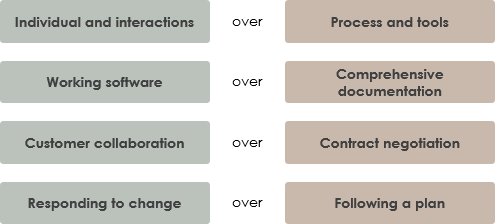Agile Manifesto
The Agile Manifesto details some fundamental agile philosophies, one of which is a preference for Empirical Process control — which maintains that knowledge is derived from experience and decision making is based on what is known.
Scrum is an empirical process based on inspection, adaptation, and transparency that aligns with the values of the Agile Manifesto and the 12 Agile Principles:

How Scrum Framework is Aligned with Agile Manifesto
The Agile Manifesto discusses the importance of people, Product, feedback and response to changes.
Scrum is consistent with the Manifesto, as its core elements are: deliver working Products every sprint, inspect and adapt every day, and trust the Team. Scrum has changed a lot since 1993. Modern Scrum, as we know it today, takes the underpinnings of the Agile Manifesto and puts it into a usable reality
Scrum is an Agile framework and, as such, is consistent with the values of the Agile Manifesto:
Individuals and interactions over processes and tools
Scrum is a team-based approach to delivering value to the business. Team members work together to achieve a shared business goal. The Scrum framework promotes effective interaction between team members so the team delivers value to the business.
Working software over comprehensive documentation
Scrum requires a working, finished product increment as the primary result of every sprint. Whatever activities take place during the sprint, the focus is on the creation of the product increment. A Scrum team’s goal is to produce a product increment every sprint. The increment may not yet include enough functionality for the business to decide to ship it, but the team’s job is to ensure the functionality present is of shippable quality.
Customer collaboration over contract negotiation
Scrum is a framework designed to promote and facilitate collaboration. Team members collaborate with each other to find the best way to build and deliver the software, or other deliverables, to the business. The team, especially the product owner, collaborates with stakeholders to inspect and adapt the product vision so the product will be as valuable as possible.
Responding to change over following a plan
Scrum teams make frequent plans. For starters, they plan the current sprint. In addition, many teams create longer-term plans, such as release plans and product roadmaps. These plans help the team and the business make decisions. However, the team’s goal is not to blindly follow the plan; the goal is to create value and embrace change. In essence, the thought process and ideas necessary for planning are more important than the plan itself.
A plan created early is based on less information than will be available in the future so, naturally, it may not be the best plan. As new information is discovered, the team updates the product backlog. That means the direction of the product likely shifts. This continuous planning improves the team’s chances of success as it incorporates new knowledge into the experience.
Scrum teams constantly respond to change so that the best possible outcome can be achieved. Scrum can be described as a framework of feedback loops, allowing the team to constantly inspect and adapt so the product delivers maximum value.
Other Scrum and Agile Articles
- The Agile Manifesto and Twelve Principles
- 10 Most Frequently Mentioned Basic Rules in Scrum
- What is Agile? What is Scrum?
- What are the Three Amigos Development Strategy in Agile?
- Empirical Process Control vs Defined Process Control
- How to Maintain Transparency in Scrum?
This post is also available in Deutsch, English, Español, فارسی, Français, Bahasa Indonesia, 日本語, Polski, Portuguese, Ру́сский, 简体中文 and 繁體中文.













